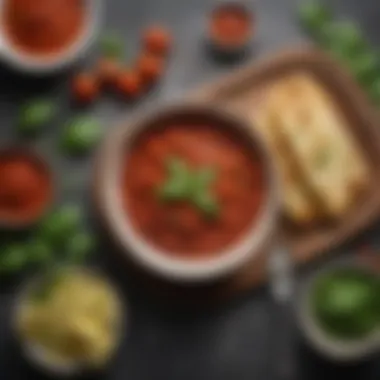Top Marinara Sauce Recipes to Try Today


Intro
The world of marinara sauce is rich and inviting, offering flavors that can transport you straight to a rustic Italian kitchen. Whether you’re stirring up a batch for a cozy dinner or prepping for a full-blown pasta party, understanding the nuances of marinara can truly change your culinary game. It isn’t just about tomatoes and spices; it’s an art, a science, and a cultural experience all wrapped into one.
Marinara sauce can be the unsung hero of many dishes – a perfect companion to spaghetti, a brazen partner to meatballs, and even a simple dip for crusty bread. The beauty lies in its versatility, allowing you to make simple tweaks to cater to different tastes or dietary requirements without losing its essence. From the homemade variety to adaptations that suit vegan, gluten-free, or low-carb diets, this guide aims to provide a comprehensive overview of marinara sauce recipes.
As we delve into the heart of this culinary staple, we’ll touch on key ingredients and tools, step-by-step instructions to whip up the perfect blend, and a few tips to elevate your sauce-making experience. This isn’t just a collection of recipes; it’s an exploration into achieving the perfect balance of flavors that will resonate with food lovers of all ages.
So roll up your sleeves and prepare to dive into the flavorful world of marinara. With each stir of the pot, you not only create a dish but also craft memories that can be savored long after the last bite.
Prelims to Marinara Sauce
Marinara sauce holds a rare place in culinary traditions, serving as a staple for countless recipes around the globe. This tomato-based concoction has worked its way into kitchens and restaurants alike, capturing the hearts of food lovers and home cooks. Understanding marinara sauce is not merely about following a recipe; it’s an exploration into its rich history, its versatility, and the flavors it brings to various dishes. By honing in on marinara sauce, one can appreciate its intricacies, boost culinary skills, and explore health-conscious options—all while enhancing the dining experience.
Historical Context
Marinara sauce isn’t just a random mix of ingredients; it has roots that weave through time. Originating from Naples, Italy, this sauce was born out of necessity rather than luxury. In the early days of tomatoes in Europe, they were initially viewed with suspicion. However, as culinary practices evolved, so did this vibrant fruit's status. By the 18th century, the marriage of crushed tomatoes, herbs, and garlic took root in Neapolitan kitchens, paving the way for what we now recognize as marinara. Some interesting facts include how it was traditionally made in a simple manner, often derived from ingredients that were local and available.
Marinara sauce made its way to America through Italian immigrants in the late 19th and early 20th centuries. The simplicity of its preparation, coupled with a flavor profile that is both comforting and rich, quickly made it a beloved choice across the United States. This savory tomato sauce transformed from its modest beginnings to a widely enjoyed culinary staple. It’s birthed variations and adaptations around the world, most notably the classic spaghetti marinara enjoyed by many.
Culinary Importance
The importance of marinara sauce in culinary circles cannot be overstated. It embodies the core of Italian cuisine while also serving as a canvas for chefs and home cooks to express their culinary creativity. The straightforward recipe allows for endless experimentation, making it approachable and versatile.
Marinara sauce is integral to various dishes, extending far beyond pasta. From hearty pizzas to savory meat dishes, its uses are diverse. It brings a richness and depth of flavor that complements many ingredients, allowing them to shine. Incorporating marinara into different meals elevates the experience, making it a valuable skill for anyone looking to enhance their cooking repertoire.
Its simplicity doesn’t mean a lack of sophistication. When made well, marinara sauce can wow even the most discerning palate. The balancing act of sweetness from tomatoes, the warmth of herbs, and the kick from garlic create an intriguing flavor profile that resonates with many.
"A well-crafted marinara sauce is akin to the foundation of a masterpiece; it sets the stage for flavors to intertwine and dance together in harmony."
This statement highlights just how crucial marinara is to achieving culinary excellence.
Core Ingredients of Marinara Sauce
When it comes to crafting marinara sauce, the foundation lies in a handful of core ingredients. These elements are not merely additives but the lifeblood of the sauce, defining its flavor profile and texture. Each ingredient has its role, working harmoniously to create a sauce that is both rich in flavor and pleasing in appearance. Understanding these ingredients is essential for anyone looking to perfect their marinara.
Tomatoes: Varieties and Selection
Tomatoes are undeniably the star player in any marinara sauce. The choice of tomatoes can greatly influence the final outcome.
- San Marzano Tomatoes: These are often hailed as the gold standard for marinara. Their natural sweetness and low acidity make them ideal. They’re also recognized for their meaty texture, which allows for a sauce that is both hearty and smooth. This variety is favored in many authentic Italian recipes.
- Roma Tomatoes: Also known as plum tomatoes, they are another popular option. They have fewer seeds and thicker flesh than regular tomatoes, lending themselves well to cooking. Their balance of sweetness and acidity contributes to a well-rounded flavor.
When selecting tomatoes, whether fresh or canned, look for options packed in their juices for a deeper flavor profile. Always keep in mind that the quality of tomatoes is paramount—juicy, ripe tomatoes will elevate the sauce.
Herbs and Spices for Authentic Flavor
The inclusion of herbs and spices plays a significant role in transforming basic tomatoes into a robust marinara sauce.
- Basil: Fresh basil is the quintessential herb for marinara. It imparts a fragrant, sweet note that pairs beautifully with the acidity of tomatoes. Adding it towards the end of cooking preserves its freshness.
- Oregano: This herb lends an earthy and slightly bitter flavor, which balances the sweetness of the tomatoes. Dried oregano is a common choice, as it loses potency when heated for too long, while fresh oregano can be added at the end of the process for a brighter flavor.
- Garlic: Often sautéed first to create a savory base, garlic introduces a rich aroma and depth of flavor. The amount can be adjusted according to personal preference, with some opting for a bold garlic hit and others favoring a subtle undertone.
- Red Pepper Flakes: For those who prefer a kick, a pinch of red pepper flakes can elevate the sauce, giving it a delightful heat without overpowering the other flavors.
Acidic Components: Balancing Taste
Acid plays a crucial role in rounding out the flavors in marinara sauce. It creates balance, enhancing the sweetness of tomatoes and adding brightness to the dish. Common acidic components include:
- Red Wine: Adding a splash of quality red wine during the simmering process can introduce complexity and depth. It lifts the flavors of the sauce and gives it a richer character.
- Vinegar: A splash of red wine vinegar can be used as a substitute for fresh tomatoes with less acidity. This invites a sharp joy to the overall flavor, providing necessary depth.
- Sugar: While it may seem counterintuitive, a small pinch of sugar may be added to counteract excessive acidity. This is a common practice, especially if the tomatoes are particularly tart.
Understanding how these acids interact with your ingredients will fine-tune your sauce into a balanced masterpiece.
"A well-prepared marinara is defined not by the individual ingredients, but by their harmony. The true magic lies in the relationships between tomatoes, herbs, and acids that create a symphonic flavor profile."
Techniques for Crafting Marinara Sauce


When it comes to creating a truly flavorful marinara sauce, the process is as important as the ingredients. The different techniques you employ can elevate the dish from basic to unforgettable. Understanding each step allows the home cook to master this classic sauce. In this section, we'll dive deep into the essential techniques that lay the foundation for a marinara sauce that hits all the right notes.
Sautéing: Essential First Step
The road to a great marinara begins with sautéing. This first step is not just about cooking the garlic, onions, or any other aromatics; it’s about developing a flavor base. As you heat the oil, the aromas will start to dance in the air, filling your kitchen with an inviting scent. It’s crucial to monitor the heat at this juncture. Too high, and you'll risk burning those delicate ingredients; too low, and you won't extract their full flavor potential.
Be mindful of these things when sautéing:
- Type of oil: Olive oil is traditional, but feel free to blend with other oils for different flavors.
- Timing: Onions should become translucent, while garlic should be added later to prevent bitterness.
The goal here is to create a rich, aromatic foundation that will carry through the entirety of your sauce.
Simmering for Depth of Flavor
After you’ve sautéed your base, it’s time for the sauce to sing. Simmering is where the magic often happens. As the sauce cooks, the ingredients have the opportunity to meld together beautifully. This step is where you will really see the beauty of a slow-cooked marinara. Start with a gentle heat; the sauce should bubble softly, rather than boiling violently.
Here are a few pointers for effective simmering:
- Separate Ingredients: Adding tomatoes or any sprigs of fresh herbs here allows the simmering process to coax out complex flavors.
- Time it Right: A mere few minutes won't do; an hour or longer lets the sauce deepen. The flavor will grow richer, and that stunning red hue will emerge.
- Taste Regularly: Adjust seasoning as necessary during this time to ensure that you get the balance just right.
Letting your sauce simmer can feel like waiting for a good book to get to its climax. But trust, it’s worth it.
Blending: Achieving Desired Consistency
Once you've allowed your marinara sauce to simmer and develop a robust flavor profile, it's time to think about its texture. Depending on your personal tastes or the dish at hand, you might desire a chunky, rustic sauce or a smooth and creamy finish. Blending can help you achieve either result, and here's how:
- Tools at your disposal: Use an immersion blender for convenience or transfer to a traditional countertop blender for a finer mix.
- Control the texture: For a chunky consistency, blend just a portion of the sauce and fold it back in. This idea allows you to curate the right bite.
"The best marinara sauce is a balance of texture and taste. A little experimentation here can lead to your very own signature version."
With blending, consistency is in your hands, quite literally. Ultimately, mastering these techniques will empower you to create a marinara sauce that suits not just your palate but those of anyone lucky enough to get a taste.
Classic Marinara Sauce Recipe
When diving into the vast universe of marinara sauce, touching on the classic recipe is absolutely essential. This cornerstone not only serves as a base for many Italian dishes but also represents the heart of the culinary tradition this sauce embodies. Making a classic marinara sauce allows for a deep understanding of flavors, ingredient interactions, and the craftsmanship that goes into creating a simple yet delightful sauce.
Ingredients and Preparatory Steps
To craft the perfect classic marinara, one must start with a careful selection of ingredients. The foundation consists of ripe tomatoes, typically Roma or San Marzano varieties, which are known for their rich flavor and lower water content. Other key players include:
- Extra virgin olive oil: Enhances the taste and adds depth.
- Garlic: Freshly minced, it's vital for that aromatic essence.
- Onions: Adds sweetness and complexity.
- Fresh basil: Brightens the sauce with its aromatic profile.
- Salt and pepper: For seasoning.
- Crushed red pepper flakes (optional): For those who enjoy a bit of heat.
Preparatory Steps:
- Start by washing the tomatoes and gently blanching them in boiling water. This helps peel off the skins easier.
- While the tomatoes cool, dice the onions and garlic, setting them aside for later.
- When cool enough to handle, remove the skins and roughly chop the tomatoes.
- Prep your herbs by tearing the fresh basil leaves; they're better released in flavor this way.
Cooking Instructions
Once the prep is done, it's time to let the cooking magic happen. Here’s how:
- Heat a large pot (preferably a heavy pot like cast iron) over medium heat, adding a good splash of extra virgin olive oil.
- Sauté the onions until they turn translucent, which usually takes about 5 minutes. Follow with the minced garlic, cooking for only a minute or two until fragrant – be cautious not to brown the garlic, as this could create bitterness.
- Add the tomatoes to the pot, stirring gently. If favoring a smoother sauce, you can use a potato masher to help break them down.
- Season with salt, pepper, and crushed red pepper flakes if using. Stir well, and let this simmer on low heat, allowing the flavors to meld for about 20-30 minutes. The sauce should thicken to your desired consistency.
- Finish off by adding the fresh basil in the last few minutes of simmering. This will preserve its vibrant flavor and color.
Tip: Taste regularly during cooking; seasoning adjustments are key to balancing flavors and enhancing the final product.
Serving Suggestions
The beauty of classic marinara is its versatility. To make the most of your creation:
- Toss it with freshly cooked spaghetti to create a simple yet satisfying meal.
- Use as a pizza sauce; spread a layer on pizza dough before adding toppings for a flavorful base.
- Employ as a dipping sauce for breadsticks or mozzarella sticks to elevate your appetizers.
- Complete a lasagna by layering it between sheets of pasta and cheese for a truly indulgent dish.
In essence, a classic marinara sauce is not just a recipe; it’s a canvas to explore myriad flavors, making it indispensable in any home cook's repertoire. With these instructions in hand, you’re well on your way to mastering a sauce that echoes traditional Italian kitchens and delights palates around the world.


Variations of Marinara Sauce
When you think of marinara sauce, the classics probably come to mind. But the beauty of marinara lies in its versatility. As the demands and tastes of diners evolve, so too does this beloved sauce. Variations can turn a simple dish into something exciting, reflecting personal preferences and health considerations. They allow home cooks and professional chefs alike to put their unique spin on an age-old recipe, making it a canvas for creativity in the kitchen. In this section, we’ll explore some popular twists that enhance flavor while staying true to the essence of marinara.
Spicy Marinara
If you’re one for a little kick in your meal, spicy marinara is your go-to variation. By adding heat, you elevate the sauce from typical to extraordinary. The secret to a good spicy marinara lies in the type and amount of heat you introduce. Some may prefer crushed red pepper flakes for a straightforward approach, while others might venture into exotic territory with fresh jalapeños or even habaneros.
- Key Ingredients:
- Crushed red pepper flakes or fresh chili peppers
- Garlic (always good in marinara)
To craft your spicy marinara, start with the standard base—your tomatoes, onions, and garlic. Sauté your aromatics and then sprinkle the heat to your liking. Remember, it’s wise to start with a small amount; you can always add more, but you can't take it out once it’s in. Pair this sauce with a simple spaghetti dish or use it as a spicy dip for crusty bread.
Vegetable-Infused Marinara
For those looking to pack in the nutrients or simply incorporate more vegetables into their diet, vegetable-infused marinara presents an excellent option. This method not only adds flavor but also makes for a heartier sauce that can stand alone as a main dish.
- Suggested Vegetables:
- Carrots
- Zucchini
- Bell peppers
- Spinach
Start by finely chopping or grating your chosen vegetables. Sauté them alongside your onions and garlic until tender, letting all those lovely flavors mingle. Once everything is soft and fragrant, add in your tomatoes and other ingredients. This approach not only enhances the overall texture but also provides an array of vitamins and minerals. Serve it with pasta, or use it as a filling sauce for lasagna to keep things balanced and health-conscious.
Seafood Marinara Adaptations
For a touch of the sea, seafood marinara offers a delightful twist that's particularly popular among coastal communities. Incorporating seafood brings an entirely new flavor dimension and makes for a more sophisticated dish. The classic preparation often includes shrimp, calamari, or even mussels, each bringing its unique essence to the mix.
- Common Seafood Ingredients:
- Shrimp
- Calamari
- Clams or mussels
To achieve this delectable outcome, start with your marinara base. Consider adding some white wine for a depth that pairs well with the briny flavors of the seafood. Once your sauce is simmered nicely, add in your seafood towards the end of the cooking process, allowing just enough time for everything to cook through without becoming rubbery. This dish pairs wonderfully with linguine or simply served with some crusty bread to soak up that wonderful sauce.
A good marinara doesn't just complement; it elevates the entire meal.
Each of these marinara variations not only enhances what could be a pedestrian sauce but also showcases the remarkable adaptability of marinara in culinary traditions across the world. No matter which route you choose, these twists promise to keep your meals exciting.
Using Marinara Sauce in Different Dishes
Marinara sauce stands as a universal companion in the culinary world. It stretches far beyond a simple pasta sauce. In this section, we will explore its significant role across various dishes, showcasing its flexibility and appeal. The beauty of marinara lies not only in its rich flavor but also in the way it enhances a multitude of recipes, making it essential for those who crave depth and comfort in their meals. Understanding how to use marinara can elevate ordinary dishes into delightful culinary experiences.
Pasta Pairings
When most people think of marinara, pasta is the first dish that springs to mind. This sauce isn’t just a flavorful addition; it serves as the heart of many traditional pasta recipes. Think spaghetti, penne, or linguine—each type of pasta pairs uniquely with marinara, enhancing its profile.
- Spaghetti Marinara: A classic dish where long strands of spaghetti are coated in smooth, rich marinara. The sauce clings beautifully, allowing each bite to burst with flavor.
- Penne al Marinara: The tubular shape of penne offers a delightful texture, as marinara fills each piece of pasta, creating a balanced bite.
- Linguine: Flat and wide, linguine captures marinara in a way that ensures a hearty serving of sauce in every mouthful.
To make these pairings shine, don't forget to finish with a sprinkle of fresh basil or a drizzle of high-quality olive oil. These final touches elevate the dish, turning it into something worthy of a restaurant experience.
Pizza Applications
Marinara is not merely confined to pasta; it's also an integral component of various pizzas. When it comes to crafting the perfect pie, marinara sauce can either be a base or serve as a delicious topping, depending on the style.
- Neapolitan Pizza: Traditional margherita style uses marinara as a base, allowing the tomatoes to permeate through the crust and mingle with fresh mozzarella and basil, creating a symphony of flavors.
- White Pizza with Marinara Drizzle: For those who prefer a less tomato-forward experience, consider a white pizza topped with Ricotta and mozzarella, finished with a drizzle of marinara for just the right amount of tang.
- Supreme Pizza: Load up a pizza with all your favorites—pepperoni, mushrooms, and olives—and pour marinara over the top before baking it; the sauce encapsulates the toppings for a flavorful finish.
Marinara as a Dip
An often overlooked but delightful application of marinara sauce is its use as a dip. Inspired by the creativity frequently seen in Italian-American cuisine, marinara can transform a simple gathering into a fun-filled, flavorful experience.


- Breadsticks and Marinara: Breadsticks served warm with a side of marinara are a hit. The buttery, crunchy exterior pairs perfectly with the sauce's acidity, creating a satisfying contrast.
- Fried Mozzarella: Crispy, cheesy bites of fried mozzarella drizzled or dipped in warm marinara provides a delightful starter. The flavors mingle, providing a mouthwatering experience that guests adore.
- Vegetable Platter: Consider offering marinara alongside a selection of fresh veggies for a healthy yet tasty option. Carrots, bell peppers, and zucchini make for excellent dippers.
The versatility of marinara sauce allows it to transcend its traditional use, turning everyday meals into vibrant, enjoyable experiences.
Storage and Preservation Techniques
Storing marinara sauce properly goes beyond just saving it for later. It ensures you keep its vibrant flavors and delivers the best experience when you finally dig into that comforting dish. Marinara sauce tends to have a host of ingredients that can degrade over time if not treated right. By understanding the best practices for storage and preservation, you can enjoy your homemade sauce at its peak freshness, even weeks or months later.
Refrigeration Guidelines
After you've cooked up a pot of marinara sauce, the first step is deciding how you’ll save this culinary treasure. Refrigeration comes into play if you plan to use it within a short timeframe. Here are some pointers to get you started:
- Cool Before Refrigeration: Let your sauce cool at room temperature for about an hour. Sticking it straight into the fridge while it’s still hot can raise the fridge temperature, putting your other foods at risk.
- Use Airtight Containers: Transfer your sauce into containers that seal tightly. Glass jars or BPA-free plastic containers are excellent choices. They ensure the sauce doesn’t absorb any unwanted odors from the fridge.
- Labeling Dates: Write down the date when you made the sauce. Generally, marinara sauce can last for about 5 to 7 days in the fridge. Keeping track of time will help you avoid any unpleasant surprises later.
"Proper storage of marinara not only allows for better maintenance of flavors but extends the enjoyment of each delicious bite."
Freezing Your Marinara Sauce
When you need a longer shelf life, freezing is your friend. Marinara sauce is freezable, and knowing how to do it right can be a game-changer:
- Portion It Out: Rather than freezing all your sauce in one big batch, divide it into smaller portions. This makes it easier to thaw just what you need for a quick meal. Use freezer bags or containers that are meant for freezing.
- Leave Room for Expansion: Liquids tend to expand when frozen, so make sure not to fill your containers to the brim. Leave at least an inch of space at the top.
- Thawing the Right Way: If you’re in a hurry, put the frozen marinara in the microwave or submerge the bag in cold water. But ideally, thaw it in the fridge overnight for the best texture and flavor retention.
Overall, taking the time to store and preserve your marinara sauce properly will only enhance your future meals. The careful handling will keep the delicious essence of your culinary work intact, making every bite worthwhile.
Health Considerations in Marinara Sauce
Marinara sauce, often thought of as a simple red sauce, can carry a wealth of health benefits when crafted with care. It’s not just a flavorful accompaniment to pasta or a dip for bread—its basic components provide not just taste but also nutrition. Understanding the health profile of marinara can inspire more thoughtful eating habits, especially for those paying close attention to dietary intake. Let's break down its nutritional aspects and tweaks you can make to cater to individual health needs.
Nutritional Profile
At its core, marinara sauce is rich in essential nutrients, thanks to its primary ingredient: tomatoes. The nutritional profile can vary depending on the recipe, but here are key aspects you might find in a typical serving:
- Low in Calories: A basic marinara sauce contains few calories, making it a great option for those watching their weight.
- Rich in Antioxidants: Tomatoes are loaded with lycopene, a powerful antioxidant that has been linked to numerous health benefits, including reduced risk of heart disease and cancer.
- Fiber Content: Depending on the added ingredients, certain versions of marinara can contribute dietary fiber, which is crucial for digestive health.
- Vitamins and Minerals: Marinara may provide vitamins A and C, potassium, and folate, depending on additional vegetables and herbs used, like onions and garlic.
As part of a balanced diet, marinara sauce can be a wholesome addition, offering flavor while also providing nutritional value.
While marinara’s base ingredients offer these benefits, it is essential to also watch additions like sugar or excessive sodium, which can negate its healthy aspects. A homemade version often proves healthier than store-bought brands loaded with preservatives and artificial additives.
Dietary Modifications for Health Needs
Tailoring marinara sauce to accommodate dietary restrictions or preferences is approachable. Here are several modifications that can align with specific health considerations while keeping the essential flavors intact:
- Low-Sodium Options: For those watching salt intake, using fresh tomatoes rather than canned varieties can help control sodium. When seasoning, herbs like basil and oregano can provide flavor without the need for additional salt.
- Sugar Substitutes: If the goal is to cut sugar, try naturally sweet vegetables, such as carrots or bell peppers, which can help to reduce the reliance on sugar when balancing acidity.
- Gluten-Free Choices: If gluten is a concern, marinara can still shine. Use it with gluten-free pastas such as chickpea or zucchini noodles, thereby maintaining a nutritious meal.
- Dairy-Free Versions: To make it fitting for dairy-free diets, skip any cheese or cream and instead focus on grounding flavors with umami-rich mushrooms or nutritional yeast for a cheesy essence.
- Vegetarian or Vegan Inclusions: Fortifying your sauce with lentils or beans not only adds protein but also boosts fiber content, making it more satiating.
Each modification can bring the sauce in line with various dietary preferences, ensuring everyone can enjoy this classic. Understanding health nuances with marinara can encourage thoughtful and healthier meal choices.
Culmination and Final Thoughts
Marinara sauce stands as a culinary cornerstone, exemplifying both simplicity and complexity in the kitchen. The journey through the various aspects of marinara—from its rich historical roots to its essential role in modern gastronomy—highlights its multifaceted nature. This article emphasizes not only the joy of crafting this beloved sauce but also its versatility across a myriad of dishes. The combination of core ingredients, practical techniques, nutritional considerations, and an array of unique recipes showcases why marinara sauce remains a perpetual favorite.
The Endless Appeal of Marinara Sauce
One may ask, what makes marinara sauce so adaptable and cherished among food enthusiasts? First, consider the intrinsic flavors—the sweetness of the tomatoes, the aromatic herbs, and the subtle bite of garlic. Together, they create a symphony of tastes that tantalizes the palate. Additionally, marinara effortlessly elevates a restaurant-quality meal at home. Ingenious home cooks can vary it easily, tailoring flavors to suit personal preferences or dietary restrictions.
Indeed, the endless appeal lies in its willingness to accommodate creativity, whether in a comforting bowl of spaghetti, smothered atop a pizza, or served alongside crusty bread. By following the suggested techniques and exploring the myriad variations, anyone can transform everyday meals into a delightful culinary experience. Beyond mere taste, marinara encourages exploration and experimentation—a true reflection of Italian culinary philosophy.
Encouragement for Culinary Exploration
As we wrap up this comprehensive guide, let it be clear that the world of marinara sauce is just the beginning. Every recipe shared in this article serves as a springboard for culinary adventure. Don't shy away from substituting ingredients or adding personal touches; it’s in those adjustments that new flavors are born.
Try experimenting with different herbs like basil or even introducing unexpected elements like sun-dried tomatoes or olives.
"Cooking is like love; it should be entered into with abandon or not at all."
Every batch of marinara is a unique expression of creativity, showcasing personal flair that can turn a simple dish into something extraordinary. So, grab your apron, throw on some music, and let the kitchen envelop you in a welcoming, aromatic embrace. With each cooking adventure, your artistry will improve, and your passion for creating delicious marinara sauces can flourish, bringing joy not only to you but to everyone sharing the table.
Embrace the ride, transform your culinary endeavors, and make marinara your canvas!







